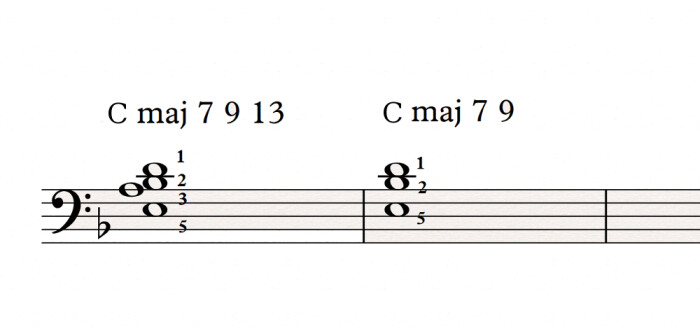In the previous article we started to discuss how to apply to the piano everything you've seen so far regarding voicings. Today we'll continue doing the same.

The third and the seventh again and again
To begin with, I invite you to reconsider the example we used in the previous article:

If you recall, the voicings were made up of chords whose root we had deliberately left out. Take a look at the lower voices of the voicings in question (hint: it’s not the bass voice!). The notes of this lower voice are: G, G and F#. They represent, respectively, the third of the first chord, the seventh of the second chord and the third of the last chord.
Okay, now I’m going to reveal a secret to you: seventh chords which don’t have a root always have the third or seventh in the lower voice! You can always build your piano voicings from each of these degrees according to the key range of your keyboard and the notes of the melody you are harmonizing. Don’t forget that the third and the seventh are a chord’s most representative notes (see article 35). So it’s interesting to find them as pseudo-basses when there is no root, isn’t it? As I’ve already mentioned a couple of times before: everything always fits together nicely in the harmonic domain!
Making added-tone chords lighter
Up to now, the voicings you’ve seen have been based on added-tone chords made up of four sounds (without the root). Yet, as you know, it is often the case that you need to free up some space and make the chords lighter. So the question is: which notes should you do away with to preserve the added-tone color of your voicings? Here are a couple of examples that touch on this issue:

The first voicing is based on a Cmaj 7 9 13 chord without the root and built on top of the third, E. The second voicing represents a lighter version of the first one, without the 13th (A). As you can hear, despite everything, the overall color of the voicing remains the same.
Let’s see now what happens with a rootless chord built on top of the seventh, like on the first of the two voicings below:

In this case, it’s not the 13th that disappeared but the 9th. Did you notice anything special about the last examples we used? Like the second voice of the voicing being always the one to be taken out of the equation?
Once again, here are the same examples with the fingering for the right hand:
Summing up today’s article, you could say that the voicings without root are built on top of the third or seventh of the original chord, and that you can make them lighter taking out the second note from the bottom.





